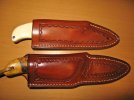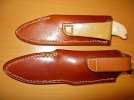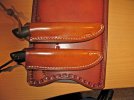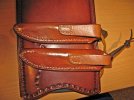- Joined
- Nov 13, 2004
- Messages
- 650
Hi All,
I've watched this forum for quite a while but seem to finally have been bitten by the bug. Hopefully I can make something presentable if I stick with it. I recently bought the videos by Paul Long and Chuck Burrows but there's so much there that it will take a while to absorb.
Below are some pics of some sheaths I've tried lately. They look better than my first attempts but I make so many foolish mistakes that it drives me crazy.
I'd really appreciate any thoughts on how to improve. Especially how to avoid the unsightly bulges at the top of the welts when I bring the welt up high like in the first two pics? The top one is a Spyderco Mule and the spine has a strong downward cure. The bottom on is a Spyderco Bushcraft and has a relatively thick handle. They fit well enough but...
Thanks,
Dave




I've watched this forum for quite a while but seem to finally have been bitten by the bug. Hopefully I can make something presentable if I stick with it. I recently bought the videos by Paul Long and Chuck Burrows but there's so much there that it will take a while to absorb.
Below are some pics of some sheaths I've tried lately. They look better than my first attempts but I make so many foolish mistakes that it drives me crazy.
I'd really appreciate any thoughts on how to improve. Especially how to avoid the unsightly bulges at the top of the welts when I bring the welt up high like in the first two pics? The top one is a Spyderco Mule and the spine has a strong downward cure. The bottom on is a Spyderco Bushcraft and has a relatively thick handle. They fit well enough but...
Thanks,
Dave




